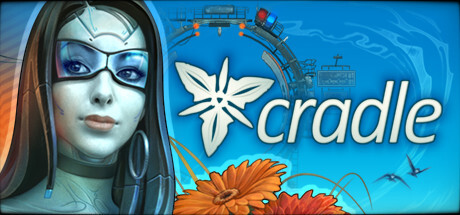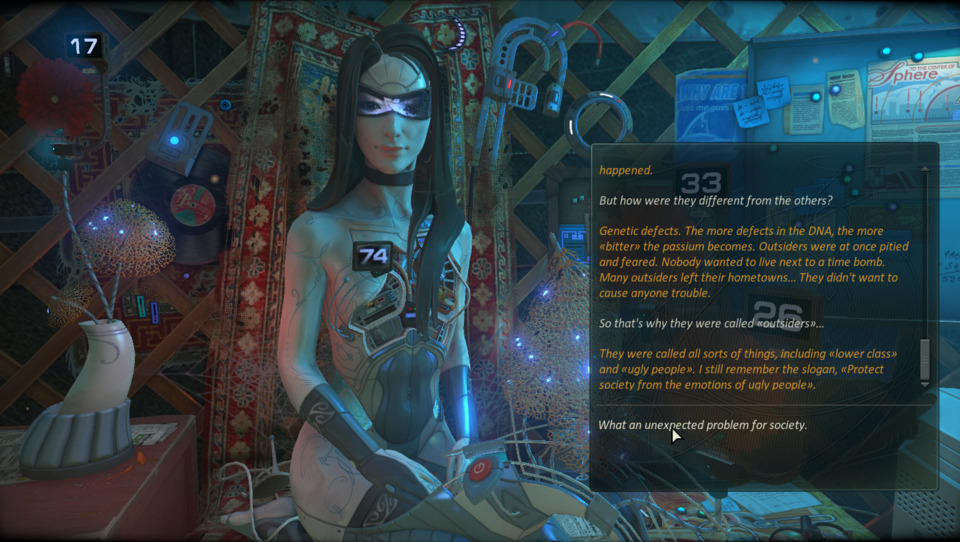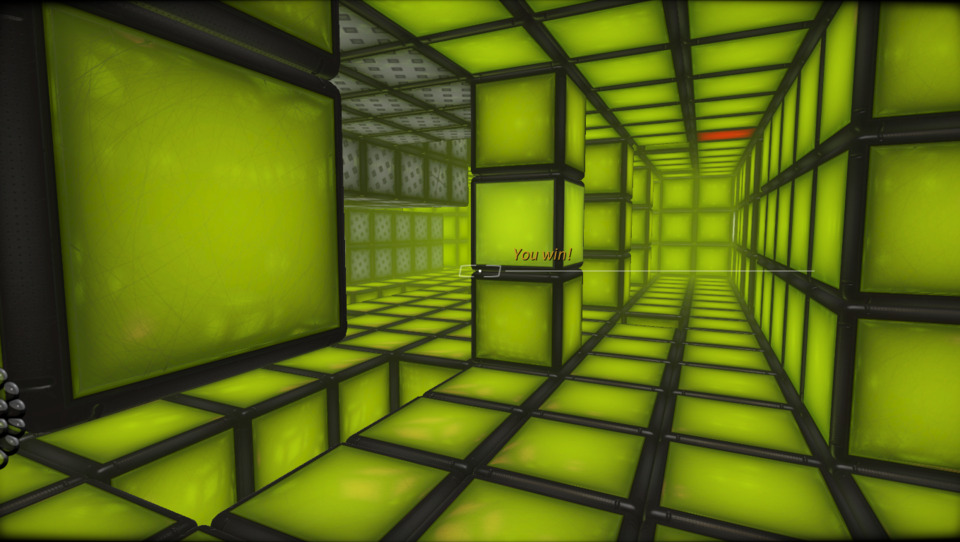
There are some games where a bunch of flaws aren't enough to tarnish a shining core of imaginative storytelling and game design. I felt this way about Outer Wilds, and to a similar extent towards this week's game, Cradle, released all the way back in 2015 by the oddly-named Flying Cafe for Semianimals. In Cradle you wake up in a Mongolian yurt in the year 2076, having no memory of who you are or what you're doing in such a remote part of the world. Following a cryptic note left behind by your possible past self, you eventually piece together that the human race is on the brink of annihilation due to an unusual epidemic caused by a disease explosively generated through strong negative emotions. The yurt is a cluttered den of traditional Mongolian furniture and artifacts along with some high-tech gizmos that look out of place, none more so than a gynoid sitting on a desk that you're eventually able to wake up and communicate with. Her name is Ida and she's every bit as confused as you are about this place and how she got there.
Cradle initially has the vibe of an exploratory first-person adventure game; those often pejoratively labelled as walking simulators, but tend to be modern interpretations of the format established by the deeply obtuse Myst series and its emphasis on environmental puzzles and copious amount of lore written in note form as a major source of incidental exposition. However, Cradle eventually reveals a second side, and one that might not be to the taste of those expecting a sedate, reading-heavy narrative adventure: a series of puzzle rooms that require quickly navigating the space via frantic 3D platforming. More on those in just a moment. As you spend the first hour or so of gameplay inside or just outside that yurt completing objectives, first cooking a meal for a creature named Ongot—which turns out to be a large golden eagle with an unusual chest cavity—and then figuring out how to activate and talk to Ida, it's safe to assume the rest of the game follows a similar rhythm. It's only when Ida starts to break down because she's lacking a vital robotic component, or she needs you to gather information, that you find yourself hiking to the only other notable location in the vicinity: an abandoned theme park named the Gerbera Gardens filled with broken down animatronics, VR playrooms, and ominous whispering black swirls that give chase once you get too close.

These VR playrooms are where the game's other half makes itself known. In each, you navigate a multi-floored open environment full of cubes that has a rising column of air in the middle and a base filled with knee-deep water. The goal of these rooms is invariably to find thirty cubes of a specific color (most are gray, only a small fraction are not), grab them from the environment, and launch them into the central flue so they can be collected by a device at the top. While you're doing this, you're assaulted by creatures that explode parts of the environment to make navigation harder, as well as a regular event where the flue vanishes and a vortex appears that sucks in loose cubes and those closest to the center. You essentially have a time limit to recover the necessary number of colored cubes, using the flue yourself to ascend to the higher floors, while avoiding the water at the bottom as it causes a penalty that removes some of the cubes you've procured so far. Additional rules make themselves known in other instances of this puzzle room, such as combining colored cubes with white cubes to create new platforms (this usually generates more colored cubes in the process) or combining them with red cubes to create bombs that also have their uses. It can be a little intense, especially as time continues and fewer colored cubes are visible, but there's always the option to skip the whole mini-game if it proves to be the less compelling half of Cradle's equation. I was able to complete them all but I certainly wouldn't consider them to be the highlight; 2015 might've been right around the time these contemplative, text-heavy adventure games were getting excoriated by certain corners of the game-reviewing public, so I'm half curious if these puzzle rooms were only added as a means of providing "actual gameplay" to pacify these narrow-minded types.
In contrast with these plain and self-explanatory puzzle rooms, the central environment of the protagonist's yurt is a joy to explore despite its small size due to a plethora of environmental details to observe. The place is filled with elucidating scraps of newspapers and other notes that are spread across the floor and found in every drawer, while certain parts of the yurt—like a drawer locked by what resembles a keycard reader and a massive trunk with a padlock on it—remain mysteries for most of the playthrough. Ida's an enigmatic character that offers her help in solving the protagonist's dilemmas, though is somewhat at a loss herself due to the advanced state of decay of her gynoid's inner-workings; you find out she was once a human, having temporarily downloaded her consciousness into an artificial "m-body" like most of mankind in order to elude the plague, and that she has some link to Gerbera Gardens she cannot recall. Solving the mysteries behind her presence is, naturally, linked with your own unknown origin and the game builds to a open-ended conclusion that is open to interpretation; whether this was by design or the result of a lack of time to create something more definitive is also left to the player's imagination. A strong case can be made for the former given how the game comports itself, abandoning the player to suss out what's happening from the copious amount of written material that surrounds them regarding the plague, the current state of the world, an unfortunate recent focus on genetic superiority as a means of combating the virus, and thoughts on transhumanism in general as everyone deals with the struggles of walking around in artificial shells as their organic bodies are preserved elsewhere. Definitely feels like a game world inspired by Myst and its ilk, for better or worse.

I spoke of flaws, and in addition to the preponderance of those puzzle rooms I was largely indifferent towards—they felt kinda superfluous at best—there's also a number of glitches that can be downers. The game's not one that lets you make manual saves, so there's a possibility you might drop an item and have it completely vanish on you, falling through the environment or some other malady that makes it impossible to proceed. This can certainly be the case early on where you're preparing Ongot's meal with a necessary selection of ingredients and preparatory tools. I kept having the cursor appear in the center of the screen (dropping in and out of the pause menu tended to remove it) and many of the note items looked so much like background textures it was hard to know what I could interact with. The puzzles were never too difficult and you could pull up a minor hint with the Tab key at any time, but some objectives did feel more vague than others. One goal close to the end of the game required you place an object in a "ruined flowerbed" when the actual target was a single sculpture within Gerbera Gardens, which was also one of several identical sculptures. Given how small the game world is there's not too much wandering around lost with ambiguous targets like this, but it's an ever-present issue with the adventure game genre as a whole that evidently this game was also unable to crack. Last, the voice acting is uniformly pretty bad, with one exception in the sympathetic Ida who fills her voice recordings with a germane mix of a dispassionate doctor (turns out her human self was a psychologist) and a confused and scared woman who has awoken in a strange environment in a deeply compromised and immobile state. The protagonist's own detached mode of speaking may or may not be relevant to their character arc, but it wasn't a compelling performance either way.
In spite of its shortcomings, Cradle's a fascinating game that operates with some heavy themes and an economical amount of real estate to deliver a thoughtful, cryptic narrative about an unrecognizable future couched in a similarly unrecognizable (to most players) traditional Mongolian setting. It's the kind of hands-off storytelling that could resonate with a certain audience, though just as many might be put off by its lack of concrete conclusions or its reliance on these just-whatever puzzle rooms as a means of artificially padding out an already short runtime. I will say it's a very attractive game, barring the aforementioned flat texture-resembling correspondence: the Mongolian wilderness strikes a balance of loneliness and beauty, while the yurt's busy, lived-in interior with its mishmash of the old and new along with the formerly-surreal, currently-dilapidated aesthetics of Gerbera Gardens really stand out. It's because of the game's looks that it's only been until recently that I had a system that could run it well, though it turns out not all of its technical problems were the fault of an inadequate rig. The very model of a flawed gem, yet one that has plenty to offer those looking for a pensive, sophisticated sci-fi narrative in their video games.
Rating: 3 out of 5.
| < Back to 312: Mutant Year Zero: Road to Eden | 001-100 | 101-200 | 201-300 | > Forward to 314: Amnesia: Rebirth |

Log in to comment